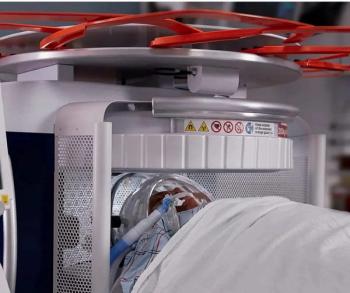
Researchers seek reduction in imaging follow-up of common incidental brain MR findings
Incidental findings in brain MR imaging of asymptomatic subjects show a high prevalence of low-risk meningiomas and small aneurysms. Researchers suggest a review of management guidelines for such findings, with an eye toward reducing radiological intervention.
Incidental meningioma (arrows) found in patient undergoing MR scan to document natural changes in aging brain. (Provided by A. van der Lugt)
Incidental findings in brain MR imaging of asymptomatic subjects show a high prevalence of low-risk meningiomas and small aneurysms. Researchers suggest a review of management guidelines for such findings, with an eye toward reducing radiological intervention.
Dr. Meike W. Vernooij, a radiologist at Erasmus MC University Medical Center in Rotterdam, the Netherlands, and colleagues reviewed the structural brain MR scans of 2000 adults (45 to 96 years, 52% women). Subjects were part of the Rotterdam Scan Study, which aims to investigate the causes and consequences of age-related brain changes.
The researchers found asymptomatic brain infarcts in 7.2% of subjects. Among findings other than infarcts, cerebral aneurysms (1.8%) and benign primary tumors (1.6%), mainly meningiomas, were the most frequent. The prevalence of asymptomatic brain infarcts and meningiomas increased with age, as did the volume of white matter lesions. Aneurysms showed no age-related increase in prevalence, according to the study published in the Nov. 1
New England Journal of Medicine.
The meningiomas ranged from 5 mm to 60 mm in diameter. Other benign tumors included pituitary macroadenomas and vestibular schwannomas.The growth rate of meningiomas is typically slow, and most remain asymptomatic throughout life. Nevertheless, current practice dictates close clinical and radiological follow-up to rule out rapidly enlarging tumors. Many clinicians perform MRI yearly for at least two to three years to ascertain that rapid tumor growth does not occur, according to the study. If this follow-up were done for all persons incidentally found to have meningiomas, many MRI exams would be performed in otherwise healthy asymptomatic persons, at a considerable financial and psychological cost, senior author Dr. Aad van der Lugt told
Diagnostic Imaging.
Researchers noted that guidelines for the management of small aneurysms might also be reviewed. In the study, all aneurysms except two were located in the anterior circulation, and all except three were less than 7 mm in diameter. The reported risk of rupture for aneurysms of this size in the anterior circulation over a period of four years is 0%. Researchers suggested that preventive surgery or treatment of risk factors is not indicated. The benefit of longer follow-up has not yet been proven.Subjects in the Erasmus University study with aneurysms less than 7 mm in diameter in the anterior circulation were not referred for follow-up or medical treatment."The number of brain MR scans obtained in the clinical and research setting increases each year, and scanner equipment and scanning protocols become more sensitive to detect subtle abnormalities," van der Lugt told
Diagnostic Imaging.
"As a result, clinicians and researchers will be confronted more frequently with incidental brain findings."Van der Lugt added that information on the natural course of incidental meningiomas and small aneurysms could reveal that the majority will not lead to serious morbidity or mortality. "If this is indeed true, we would expect that the recommended follow-up -- for example, repeat imaging -- and/or treatment for these incidental brain findings can be less rigorous than is currently the case in clinical practice," he said. Only two subjects with incidental brain findings had reported any symptoms. One person with vestibular schwannoma reported hearing loss that had been investigated three years earlier by CT, which had not revealed any abnormalities. Another person, who had a right-sided intravestibular lipoma, had long-standing ipsilateral hearing loss that was never evaluated.The prevalence of subclinical vascular pathology and its increase with age were not surprising, as they had been previously reported. But the prevalence of meningiomas and small aneurysms was much higher than previously reported. Van der Lugt said the difference was likely due to the scanning protocol, especially the high-resolution proton-density-weighted sequence, which permitted very good visualization of the circle of Willis as compared with conventional T1- and T2-weighted sequences. For more from the Diagnostic Imaging archives:
Time-resolved MR angiography revolutionizes clinical imaging
Functional MRI helps brain tumor treatment
Multislice CTA gains edge over DSA for brain aneurysm detection
Newsletter
Stay at the forefront of radiology with the Diagnostic Imaging newsletter, delivering the latest news, clinical insights, and imaging advancements for today’s radiologists.


























